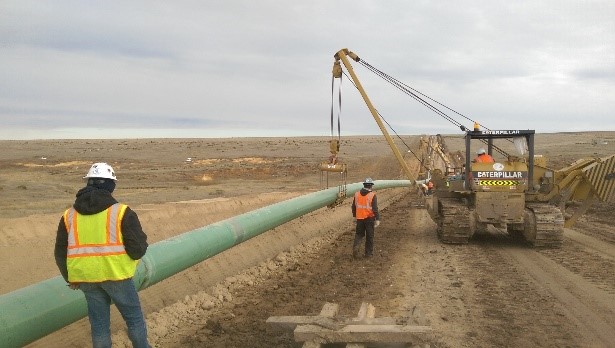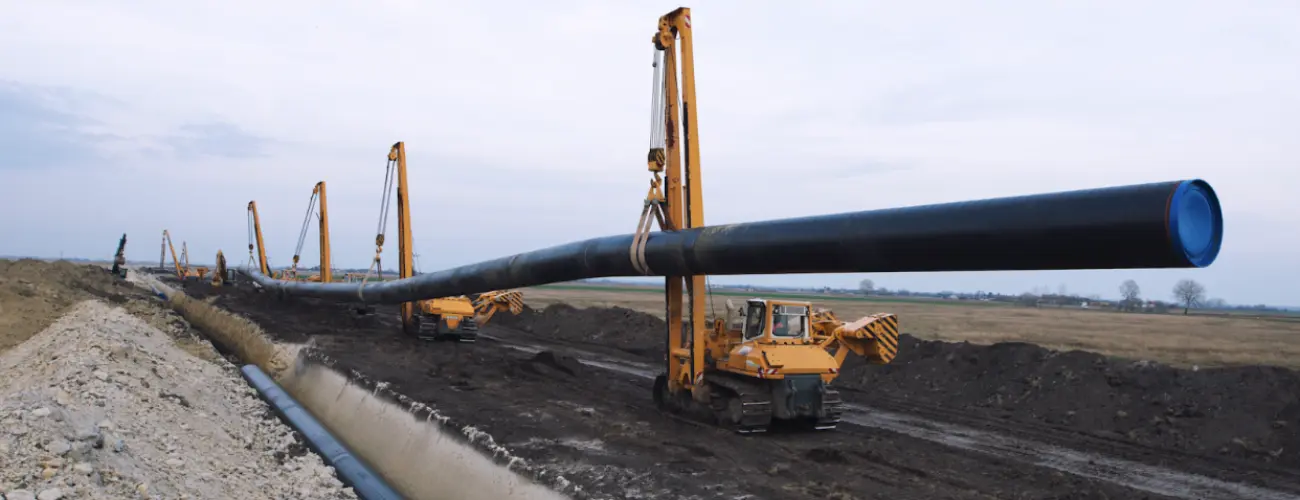Everything You Need to Know About Creek Pipe pipeline construction
Wiki Article
What You Ought To Learn About Pipe Trenching Providers: A Thorough Introduction of Available Options
Pipe trenching solutions are crucial for the installment and upkeep of underground utilities. They entail various approaches customized to specific needs and settings. Comprehending these approaches is key for effective task execution. Each option provides its own set of benefits and challenges. As the need for efficient utility administration boosts, knowing what to consider when selecting a trenching solution becomes crucial. What variables should one focus on to ensure success?Understanding Pipe Trenching: What It Is and Why It Issues
Although commonly overlooked, pipe trenching is a crucial procedure in numerous construction and utility jobs. This technique entails digging deep into slim trenches to promote the installment of pipelines for water, gas, sewer, and telecoms. The importance of pipeline trenching hinges on its function in making sure that these vital systems are appropriately integrated into framework, enabling the risk-free and effective delivery of necessary services.Proper trenching is crucial for keeping the honesty of pipelines and decreasing dangers related to dirt disintegration and collapses. It likewise permits efficient inspections and maintenance of underground energies. Furthermore, recognizing the neighborhood policies and ecological factors to consider is crucial, as incorrect trenching can lead to costly delays and lawful concerns. Eventually, pipe trenching functions as the fundamental step that supports different building endeavors, making it a considerable facet of contemporary framework development.
Common Trenching Methods for Below Ground Utilities
In the domain of below ground energies, numerous trenching methods play an important duty in installation and upkeep - Creek Pipe Midland. The open-cut trenching method, directional dull technique, and hydro excavation procedure each offer one-of-a-kind benefits depending on the certain job demands. Comprehending these approaches is crucial for effective and reliable utility monitoringOpen-Cut Trenching Technique
Open-cut trenching is a widely utilized approach for setting up underground utilities, particularly when the deepness and width of the trench enable effective gain access to. This method includes excavating a trench along the proposed path of the energy, providing direct visibility and accessibility for installation. It is particularly helpful for jobs that need extensive excavation, as it promotes quick installment and inspection. It likewise demands mindful planning to reduce disruption to the surrounding location, including web traffic and existing frameworks. Open-cut trenching is most efficient in open rooms where the soil problems are favorable, but it might be limited in urban settings because of the presence of existing energies and other below ground challenges.Directional Boring Strategy

Hydro Excavation Process
How does hydro excavation stand out among common trenching methods for underground utilities? Hydro excavation makes use of high-pressure water and vacuum modern technology to safely eliminate dirt, allowing for specific digging around sensitive below ground utilities. This technique minimizes the threat of damaging existing framework compared to typical mechanical excavation. By employing water to loosen up the dirt, hydro excavation provides a much less intrusive approach, reducing the possibility for dirt compaction and ensuring a cleaner worksite. In addition, the process enhances presence throughout excavation, boosting total accuracy and efficiency. Hydro excavation is especially valuable in urban locations where energy lines are densely loaded, making it a favored choice for contractors concentrated on security and accuracy in below ground jobs.Benefits of Trenching Solutions
While numerous techniques exist for setting up below ground utilities, trenching services supply unique advantages that make them a preferred option for lots of projects. One substantial advantage is the cost-effectiveness of trenching, as it normally calls for much less specific equipment contrasted to options like hydro excavation. This frequently results in reduced labor and operational costs. In addition, trenching can suit a wide variety of energy types, including water, drain, and gas lines, supplying versatility for contractors.Moreover, trenching allows for reliable accessibility to numerous lines in a single excavation, reducing interruption to the surrounding area. The process also enables exact setup and repair service, which is critical for adhering to regulative standards and making sure long-lasting dependability. Eventually, trenching can be implemented fairly rapidly, reducing task timelines and allowing for faster service repair. These benefits collectively make trenching solutions a practical option for numerous underground utility projects.Downsides and Difficulties of Trenching
Regardless of the countless advantages of trenching services, there are notable downsides and obstacles that need to be thought about. One substantial obstacle is the possibility for soil instability, which can bring about collapses, posing risks to workers and tools. Additionally, trenching can interrupt existing energy lines, necessitating cautious planning and coordination to stay clear of service disruptions. The procedure can likewise be lengthy, particularly in metropolitan areas where area is minimal and accessibility is restricted. In addition, trenching might require substantial authorizations and regulative conformity, adding complexity and potential hold-ups to tasks. Ecological problems, such as soil erosion and damages to local ecosystems, can occur from inappropriate trenching practices. Lastly, the prices linked with trenching, including labor and tools, can intensify if unanticipated problems occur during the job, making it necessary for stakeholders to weigh these challenges against the advantages when taking into consideration trenching services.Secret Variables to Think About When Choosing a Trenching Solution
Choosing the right trenching service can greatly affect the success of a job. Several essential elements need to be examined to guarantee an appropriate selection. The firm's experience and experience in trenching operations are vital; a well-established solution with a solid track document is typically a lot more reliable. Next, evaluating the devices utilized is basic, as modern-day machinery can boost performance and accuracy. Additionally, it is significant to take into account plumbing leak in ceiling the variety of solutions supplied, consisting of excavation deepness and dirt type handling, to verify they fulfill particular project requirements.Another aspect to testimonial is the firm's online reputation; consumer testimonials and reviews can supply understandings into previous efficiency. Furthermore, getting thorough quotes that lay out prices and timelines will aid in budget administration. Lastly, verifying conformity with regional regulations and industry requirements is crucial for preventing prospective lawful issues. By mirroring on these factors, clients can make a notified decision when selecting a trenching service.Security Steps in Pipe Trenching
In pipe trenching, precaution are crucial to guaranteeing employee defense and site honesty. Trick elements include using individual safety equipment, extensive excavation website evaluations, and distinct emergency action protocols. Applying these actions greatly lowers risks related to trenching procedures.Personal Safety Devices
Security in pipe trenching heavily depends on the appropriate use personal safety tools (PPE) Employees ought to use difficult hats to shield against falling objects, along with high-visibility vests to boost their visibility on-site. Steel-toed boots are essential for foot defense versus hefty tools and products. In addition, handwear covers are very important for hand safety and security, especially when managing harsh or sharp things. Respirators might likewise be essential in environments with dirt or unsafe fumes. Eye defense, such as security goggles, ought to be worn to secure versus particles. Finally, listening to protection is important in loud work environments. By sticking to PPE guidelines, workers can substantially minimize the danger of injury and ensure a more secure trenching operation.Excavation Site Examination
Effectively examining the excavation site is a fundamental action in assuring a risk-free pipe trenching operation. This process includes examining the website for potential risks such as below ground utilities, unpredictable dirt problems, and close-by structures. A thorough assessment enables the recognition of dangers that might endanger worker safety and security. Furthermore, verifying the dirt type and dampness levels can assist identify proper shoring methods to stop trench collapses. It is necessary to assure that the site is free from particles and that correct reference signage is shown to notify personnel of continuous operations. Routine assessments throughout the task can likewise aid identify any kind of adjustments in site problems, enabling timely modifications to precaution and work methods.
Emergency Situation Action Protocols
Emergency reaction procedures are vital in mitigating risks related to pipe trenching procedures. These procedures guarantee that all employees are prepared to act swiftly and successfully in emergency situations. Crucial element consist of regular safety drills, clear communication channels, and marked emergency leaves. Additionally, first-aid kits and emergency situation call numbers must be conveniently obtainable on-site. Trenching procedures have to additionally include treatments for dealing with hazardous scenarios, such as cave-ins or utility strikes. Training employees on acknowledging possible risks and recognizing their roles throughout an emergency is essential. In addition, keeping an upgraded website security plan can significantly enhance action effectiveness. Generally, reliable emergency situation preparedness promotes a more secure working environment and lessens the impact of unanticipated events.Cost Considerations for Trenching Solutions
Comprehending the financial effects of trenching solutions is necessary for project planning and budgeting. The prices connected with trenching can differ widely based on numerous variables, consisting of job dimension, dirt type, and depth of the trench. Labor prices commonly stand for a considerable section of the overall expenditure, as experienced drivers are required for efficient execution. Furthermore, tools service fees can add to the total budget, specifically for specialized machinery.Site access is another crucial factor; difficult terrain may demand extra sources, raising costs. Permitting and regulatory conformity can additionally include in expenditures, especially in urban areas where laws are stringent.Lastly, unforeseen problems, such as experiencing existing energies, can lead to unanticipated prices and delays. As a result, acquiring detailed estimates from reliable trenching provider is important for accurate budgeting and ensuring successful task completion.Often Asked Concerns
The length of time Does a Common Pipe Trenching Task Take?
The period of a common pipe trenching project differs significantly based upon elements such as deepness, soil conditions, try this and job intricacy. Usually, it can take anywhere from a couple of days to numerous weeks to finish.What Devices Is Typically Utilized in Pipe Trenching?

Are There Environmental Laws for Trenching Activities?
Environmental policies for trenching activities commonly require compliance with local, state, and government guidelines. These laws intend to decrease eco-friendly disruption, shield water sources, and guarantee proper waste administration throughout excavation and setup processes.
Can Trenching Solutions Be Integrated With Other Construction Projects?
Trenching solutions can without a doubt be incorporated with numerous building and construction tasks. By coordinating efforts, effectiveness can be attained, minimizing interruptions while ensuring that all necessary framework job is completed in a prompt and cost-effective manner.
What Prevail Soil Keys In Experienced in Trenching?
Typical dirt kinds come across in trenching include clay, sand, silt, and loam. Each kind offers unique challenges, influencing excavation methods and stability, requiring mindful preparation to guarantee secure and reliable trenching operations.Report this wiki page